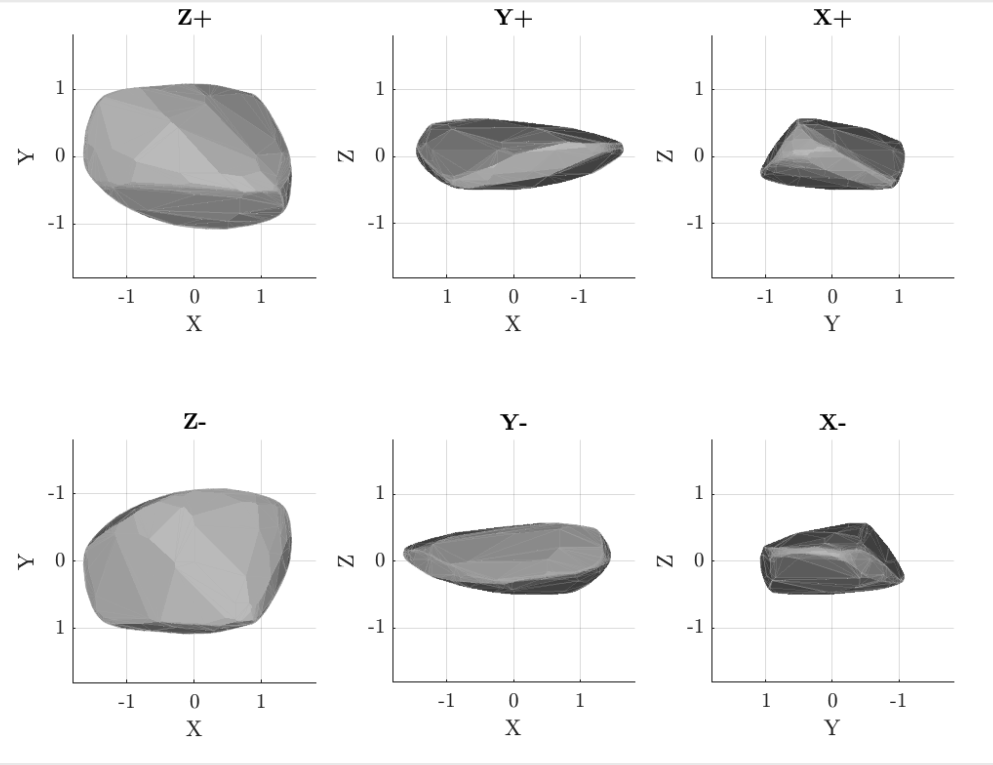The convex shape model of 162P/Siding-Spring from ground-based photometry
- 1University of Edinburgh, School of Physics and Astronomy, Institute for Astronomy, Edinburgh, UK (donaldso@roe.ac.uk)
- 2European Southern Observatory (ESO), Garching bei München, Germany
Images of short period comets returned from spacecraft have been the most valuable sources of information on their nucleus shapes and surface features to date. While there is no doubt that in situ missions are the optimal way to study individual comets in detail, ground-based nucleus observations are a much more practical means of gaining insights into the physical properties of the population as a whole. Even with relatively sparse lightcurve coverage we can extract estimates of their rotation periods, and determine their phase functions. Using precisely calibrated photometry spanning decades, Kokotanekova et al. [1] identified a correlation between increasing linear phase function slope and geometric albedo for 14 Jupiter-family comet (JFC) nuclei. It can be interpreted as a surface evolution from rough, unprocessed surfaces to smooth, eroded nuclei [2]. These results illustrate the significance of long term ground-based monitoring, with exciting implications for future study of small body surface evolution.
In this work, we seek to extend the possible applications of these JFC lightcurves to produce a convex model of a comet nucleus. The overall shape of a body has a much larger effect on its rotational lightcurve than any fluctuations in albedo or light scattering properties across the surface [3,4]. As such, it is possible to extract information about the shape of a small body from its lightcurves alone. The technique of convex lightcurve inversion is routinely used to produce asteroid shape models from their ground-based lightcurves [5,6]. This procedure takes as input lightcurves that cover a wide range of observing geometries (solar phase angle, sub-observer latitude), and uses a linear-exponential solar phase function with combined Lommel-Seeliger and Lambertian light scattering models to create a convex hull representing the object's overall shape - this has been compared to the true shape of the object being "gift-wrapped". To date, this method has been used to produce only one convex model of a comet nucleus. This was the target of the Rosetta mission, comet 67P/Churyumov-Gerasimenko [7]. The procedure mathematically cannot recreate concave features, however the presence of substantial flat regions on the model of 67P masked large concavities, later identified as the slim neck that separates the two lobes of the bilobate shape. Physical considerations regarding the criteria for stability of any shape model may also be used to infer bilobate shapes, given that it is unlikely that single-lobed objects with extremely elongated axis ratios (a/b > 2.3) would have formed naturally [8,9].
Motivated by the relative success of the lightcurve inversion at revealing the physical properties of 67P from limited ground-based observations, we apply this shape modelling procedure to comet 162P/Siding-Spring. R-band lightcurves for this object have been collected between 2007 and 2018, at phase angles in range 0.4°-12°. According to the surface evolution hypothesis, 162P is an example of a dynamically "old", evolved JFC. It has a shallow phase function slope of (0.039±0.002) mag deg-1, a low geometric albedo pR = (2.2±0.3)% - one of the darkest surfaces of all studied comets - and is a slow rotator with a synodic period of (32.853±0.002)h [2]. This is in contrast with comet 67P, which has a high albedo and steeper phase function slope [10], characteristic of what is believed to be a dynamically younger, less eroded surface [11].
The observing geometries for comets are much more limited than for asteroids: the best technique for detecting the bare nucleus without coma contamination is to observe at heliocentric distances >3 au, where the comet is far enough from the Sun that water ice is no longer expected to sublimate. This typically restricts phase angle coverage to <15°. The low orbital inclinations of JFCs further limit the fraction of illuminated surface that can be observed from Earth.
Given the limited observing geometries, using the convexinv software by Ďurech et al. [12] we have found so far that the best physical model for the 162P lightcurves results from treating them as calibrated rather than relative, which requires the additional steps of using distance-corrected magnitudes and fitting a phase function to the light scattering model. Our preliminary convex shape model is shown in Figure 1, with axial ratios a/b = 1.50 and b/c = 2.07 (where c ≤ b ≤ a are the lengths of the principal axes of inertia). The model produces artificial lightcurves from which we obtain a linear fit to the phase function after correcting for rotation. We will present the final results from this analysis at the meeting, having finalised the procedure and tested the robustness of the solution.

Figure 1: Preliminary convex shape model for comet 162P from ground-based lightcurves. The z-axis is aligned with the spin axis. Top row shows the views along positive z, y, z; bottom row shows views along negative z, y, x.
References:
[1] Kokotanekova et al. 2017, MNRAS 471 2974
[2] Kokotanekova et al. 2018, MNRAS 479 4665
[3] Karttunen H. 1989, A&A 208(1-2), 314-319
[4] Kartunnen H. & Bowell E. 1989, A&A 208(1-2) 320-326
[5] Kaasalainen M. & Torppa J. 2001, Icarus 422(2) L39-L42
[6] Kaasalainen et al. 2001, Icarus 153(1) 24-36
[7] Lowry et al. 2012, A&A 548 A12
[8] McNeill et al. 2018, AJ 156(6) 282
[9] Jeans J. 1919, Problems of cosmogony and stellar dynamics
[10] Fornasier S. et al. 2015, A&A 583 A30
[11] Vincent J-B. et al. 2017, MNRAS 469 S329–S338
[12] Ďurech et al. 2010, A&A 513 A46
How to cite: Donaldson, A., Snodgrass, C., Kokotanekova, R., and Rożek, A.: The convex shape model of 162P/Siding-Spring from ground-based photometry, European Planetary Science Congress 2021, online, 13–24 Sep 2021, EPSC2021-336, https://doi.org/10.5194/epsc2021-336, 2021.

